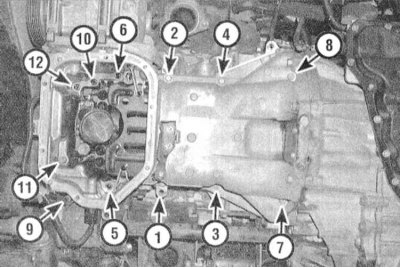Removing
1. Disconnect the negative cable from the battery.
Attention! If the stereo system installed in the car is equipped with a security code, before disconnecting the battery, make sure that you have the correct combination to activate the audio system!
2. Engage the parking brake and chock the rear wheels of the vehicle.
3. Jack up the car and put it on stands.
4. Remove the crankcase protection and right cover.
5. Remove a reception pipe of system of release of the fulfilled gases (see chapter Power and exhaust systems).
6. Drain the engine oil (see chapter Settings and ongoing maintenance).

7. The sump consists of two sections. The lower stamped steel cover is attached to the upper aluminum section, which in turn is bolted to the engine block. Moving in the reverse order shown in the illustration, unscrew the fixing bolts and remove the lower stamped section of the pallet.
Attention! To avoid damage to the tightness of the docking of components, do not pry the cover with a lever under the mating surface!

8. Remove the air conditioner compressor (see chapter Cooling, heating systems) and move it to the side without disconnecting the refrigeration lines. Remove the mounting bracket securing the compressor support bracket to the sump.
9. Hang the engine from above using a winch or beam.
Attention! Make sure that the unit is securely fixed in the raised position.

10. Turn out through bolts of forward and back support of a suspension bracket of the power unit and bolts of fastening of a cross beam. Remove a beam from the car in gathering with supports. Remove the oil filter.

11. Turn out bolts of fastening to aluminum section of the pallet of a plate of a back cover and a dome of transmission.
12. Moving from the edges to the center in the reverse order of tightening, turn out the bolts securing the upper aluminum section of the pallet to the engine block.

13. To separate the aluminum sump section from the block, pry it under the groove provided on the front side of the casting. Be careful not to damage mating surfaces.
Installation
1. Thoroughly clean the mating surfaces of the aluminum pan section and engine block, completely removing all traces of old gasket material and sealant from them. Wipe the cleaned surfaces with a cloth soaked in acetone.
Attention! To avoid the development of leaks, try not to damage the mating surfaces in the process of cleaning them.
2. Make sure that the threaded holes in the engine block and the aluminum pan section are absolutely clean - if necessary, drive them with a tap of a suitable size.
3. Lubricate the ends of the front timing cover gasket with RTV sealant, then lay the gaskets on the aluminum pan section. Lubricate the mounting flange of the aluminum section with the same sealant.
Note. The sump must be installed on the engine within 15 minutes of applying the sealant.

4. Install new O-rings on the front wall of the engine and the oil pump casing.

5. Being careful not to destroy the sealant pad, gently press the aluminum pan section against the block. Screw in the mounting bolts and, acting in a strictly defined order, tighten them in three or four steps with the required force.
6. Install the rear cover plate and transmission dome mounting bolts.
7. Check the stamped bottom pan flange for signs of deformation, paying particular attention to the condition of the flange around the mounting holes. If necessary, straighten the flange by laying it on a flat wooden block.

8. Apply a pad of RTV sealant to the mating surface of the sump flange and install the sump onto the engine.
Note. The tray must be installed within 15 minutes of applying the sealant. Working in a strictly defined order, tighten the bolts securing the pallet with the required force.
9. Further installation is carried out in the reverse order to the dismantling of the components.
10. Let the sealant dry for about 30 minutes, then install a new oil filter and fill the unit with fresh engine oil. Start the engine and check the engine oil pressure. Make sure there are no leaks.